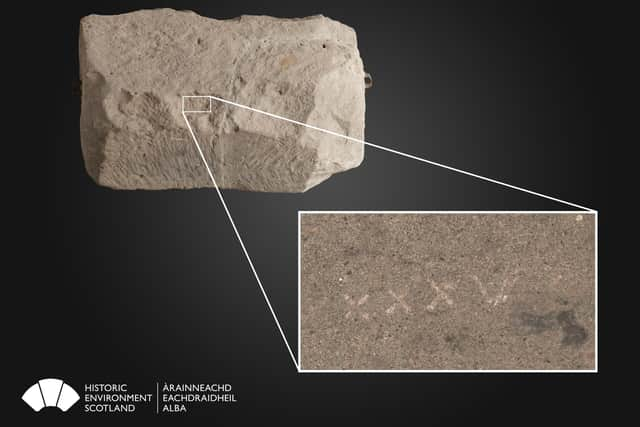Image of Stone of Destiny Roman numerals revealed with mysterious number 35


It was revealed last week that the numerals XXXV were discovered during a "health check" of the sacred sandstone as part of preparations for its transportation to Westminster Abbey for the Coronation of King Charles III.
Cutting-edge digital technology including the first 3D scan of the 152kg stone offered new clues to the history of the historic object, how it was quarried and then worked over time and new evidence of human interactions over the centuries.
Advertisement
Hide AdAdvertisement
Hide AdBut researchers are so far baffled by the Roman numerals found on the underside of the stone symbol of Scottish monarchy.


Ewan Hyslop, head of research and climate change at Historic Environment Scotland (HES) -- which looks after the Stone of Destiny -- said: "We have newly revealed some Roman numerals on the underside. There are three Xs and a V -- so 35 -- and that's never been recorded before.
"We don't yet know what that means. This is new evidence that hopefully the historians can work with and make some sense of. We want people to look at that and the historians to dig a bit deeper."He added: "The new 3D scanning data reveals a whole story of different surface markings, most of which are probably to do with the actual quarrying and shaping of the stone. We are seeing a number of different tool marks including three different types of mason's chisels -- a point chisel, a claw chisel and a flat chisel. We also know it was hammered at some time. We have clearly established there are at least three phases of working by different hands."On the top of the stone there is an attempt to cut out a recess using a very different tool. For some reason that was abandoned and never completed. The wrought iron rings were inserted at a later date, perhaps for carrying it or to secure it."
Traces of copper alloy and a dark stain on the upper surface suggest that a bronze or brass object may have been placed on the stone at some time. There are also thought to be two crosses, possibly with a religious origin.
Meanwhile, microscopic traces of white gypsum plaster found in various places suggest a cast was made at some point -- possibly in Victorian times -- although no record of this is known to exist.
Repairs carried out after the stone was damaged in 1950 - after four Scottish students famously took it back to Scotland from Westminster - can also be seen.
The Stone of Destiny -- also known as the Stone of Scone -- was used during the coronations of the Kings of Scotland until 1296 when it was seized from Scone in Perthshire by King Edward I of England.
Edward had the stone built into a new oak throne at Westminster, where it was used in the inaugurations of the monarchs of England and later of Great Britain.
Advertisement
Hide AdAdvertisement
Hide AdIt was officially returned to Scotland on St Andrew's Day in 1996 and it now sits alongside the Honours of Scotland in the Crown Room in Edinburgh Castle. It will only leave Scotland again for a coronation in Westminster Abbey.The recent study in preparation for the crowning of Charles III allowed researchers to verify that the stone was quarried near Scone, as previously thought.Mr Hyslop said: "The equipment we have got can fingerprint a stone type and so far we have matched that down to a layer of rock called the Scone Sandstone Formation which occurs around the Scone area."What is really exciting for me is that it means the Stone of Destiny is literally part of Scotland. It was formed as part of Scotland 400 million years ago and carries that geological provenance as well as all the legendary cultural significance."Rachael Dickson, HES' Regional Collections Manager, said: "Tool marks and other inscriptions have been revealed and we are not quite sure the significance of these at this stage so that's very exciting."We are trying to look at all the different theories and perhaps work with historians to develop our understanding of the history of the stone and how it has been used."
Comments
Want to join the conversation? Please or to comment on this article.